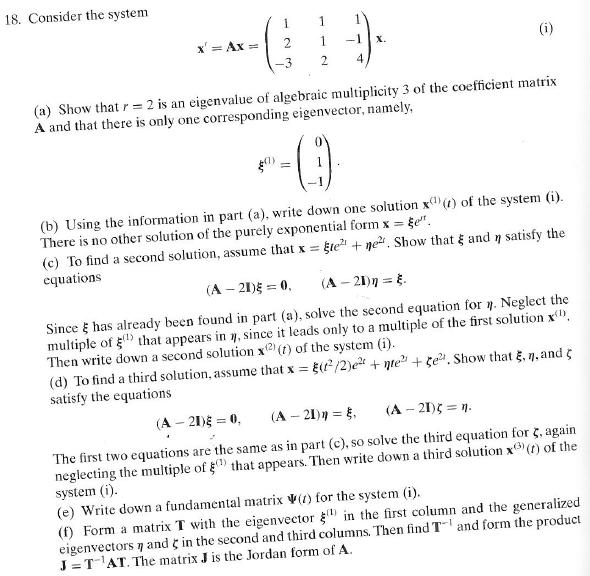Answered step by step
Verified Expert Solution
Question
1 Approved Answer
18. Consider the system 1 x' = Ax = -1 (i) . -3 2. (a) Show that r = 2 is an eigenvalue of

18. Consider the system 1 x' = Ax = -1 (i) . -3 2. (a) Show that r = 2 is an eigenvalue of algebraic multiplicity 3 of the coefficient matrix A and that there is only one corresponding eigenvector, namely, (b) Using the information in part (a), write down one solution x@() of the system (i). There is no other solution of the purely exponential form x = e". (c) To find a second solution, assume that x = gte + ne. Show that and 7 satisfy the equations %3D (A 21)5 = 0, (A - 21)n = . Since has already been found in part (a), solve the second equation for y. Neglect the multiple of " that appears in 1, since it leads only to a multiple of the first solution x, Then write down a second solution x (1) of the system (i). (d) To find a third solution, assume that x = (/2)e + nte + ge. Show that 5, n. and 5 satisfy the equations (A - 21) = 0, (A - 21) = . (A - 21)5 = n. The first two equations are the same as in part (c), so solve the third equation for , again neglecting the multiple of that appears. Then write down a third solution x (1) of the system (i). (e) Write down a fundamental matrix V(1) for the system (i). (f) Form a matrix T with the eigenvector in the first column and the generalized eigenvectors 7 and in the second and third columns. Then find T and form the product J =TAT. The matrix J is the Jordan form of A.
Step by Step Solution
★★★★★
3.30 Rating (168 Votes )
There are 3 Steps involved in it
Step: 1

Get Instant Access to Expert-Tailored Solutions
See step-by-step solutions with expert insights and AI powered tools for academic success
Step: 2

Step: 3

Ace Your Homework with AI
Get the answers you need in no time with our AI-driven, step-by-step assistance
Get Started


